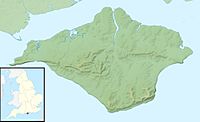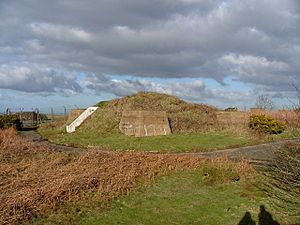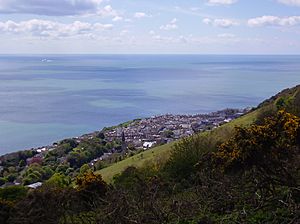St Boniface Down facts for kids
Quick facts for kids St Boniface Down |
|
|---|---|
 |
|
| Highest point | |
| Elevation | 241 m (791 ft) |
| Prominence | 241 m (791 ft) (island highpoint) |
| Listing | Marilyn, Hardy, County Top |
| Geography | |
| Location | Isle of Wight, England |
| OS grid | SZ568785 |
| Topo map | OS Landranger 196 |
St Boniface Down is a tall chalk hill on the Isle of Wight, England. It is the highest point on the island, reaching 241 meters (791 feet) above sea level. This amazing spot is located near the town of Ventnor, in the southeast part of the island. From the top, you can see incredible views. On a clear day, you might even spot Beachy Head to the east, Portsmouth to the north, and the Isle of Portland to the west!
The down is about 1 kilometer (0.6 miles) north of Ventnor. People say there's a special wishing well on its southern side. To make a wish come true, you need to climb up from the south without looking back!
Contents
A Look Back in Time
Historical Events at St Boniface Down
St Boniface Down has seen some interesting history. In 1545, a French invasion force tried to attack the area. They faced the Isle of Wight Militia, led by Sir John Fyssher. It's even said that some women archers were part of the militia! The French forces were defeated.
Later, during World War II, a radar station on the down was attacked. In 1940, German Stuka dive bombers bombed the station. This event was even recreated in the famous film "The Battle of Britain". At the very top of the down, you can also find an ancient round burial mound.
Exploring the Down's Surroundings
At the eastern base of St Boniface Down, there's a path that leads to a beautiful area called Bonchurch Landslips. You can find this path off the A3055 road, between the villages of Bonchurch and Luccombe. The path goes through a cool rock opening known as the Devil's Chimney.
Amazing Wildlife and Plants
Insects of St Boniface Down
St Boniface Down is a special place for wildlife. It is home to the largest cricket species in the British Isles. This is the great green bush cricket. You might hear its loud chirping on a warm day!
Unique Plant Life and Habitats
The area around St Boniface Down has some very unusual plant groups. These include acid grassland and heathland. Because of these rare plants, parts of the Down are protected as a Site of Special Scientific Interest.
The top layer of gravel on the down supports large areas of gorse (Ulex europaeus). Between these gorse patches, you'll find heathland and acid grassland. Here, plants like heather (Calluna vulgaris), bell heather (Erica cinerea), purple moor-grass (Molinia caerulea), and bristle bent (Agrostis curtisii) grow. In some spots, you can even find bilberry (Vaccinium myrtillus).
It's quite rare to find heathland growing on deep gravel over chalk in Britain. Also, the natural holm oak woodland and the way the heath and chalkland plants grow side-by-side make this area very special for nature.




